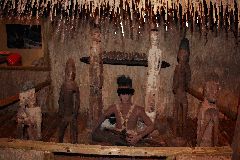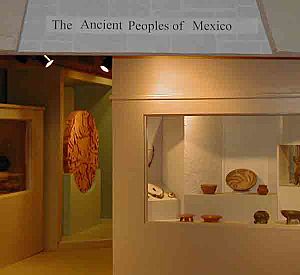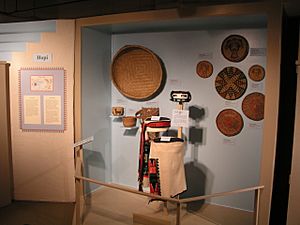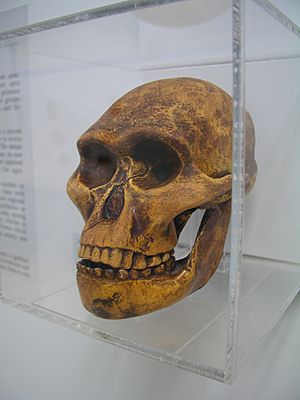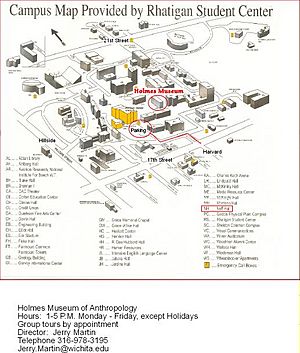Lowell D. Holmes Museum of Anthropology facts for kids
| Established | 1966 |
|---|---|
| Location | Wichita State University, 1845 Fairmount St (Neff Hall), Wichita, KS 67260 USA |
| Type | Anthropology Museum |
The Lowell D. Holmes Museum of Anthropology is a cool place to learn about people and cultures from all over the world! It started in 1966 as the Museum of Man. Dr. Lowell Holmes, an anthropology professor at Wichita State University in Wichita, Kansas, helped create it.
For many years, it was a small but interesting museum on campus. It grew slowly, adding items from different cultures and old objects found by archaeologists. These archaeological finds mostly came from the American Midwest and Southwest.
In 1999, the museum moved to a new building called Neff Hall. It became much bigger! Mr. Jerry Martin was hired as the first full-time director. His main job was to help the museum grow and develop.
Mr. Martin had a great idea: he wanted students to help run the museum. This way, students studying museums could get real-world experience. He found money to hire students to help with daily tasks. By 2006, five student positions were funded. The museum does many things. It has exhibits for everyone to see. It also keeps a growing collection of artifacts. It helps the anthropology department at Wichita State University. Plus, it's a place for students to do research. It even stores archaeological items for the United States Government. All these jobs give students lots of different experiences!
Contents
Amazing Collections to Explore
The museum has many special collections. These collections help us understand different cultures and how people lived long ago.
Art from the Asmat People
In 2001, the museum sent a team to Western New Guinea. They collected over 950 pieces of art from the Asmat people. Later that year, the museum also received the Bakwin collection, which had almost 120 more Asmat art pieces.
Asmat art is known for being large, beautiful, and very special. This collection at the Holmes Museum is becoming quite famous. Only a few other museums in the United States have similar large collections. These include the Michael Rockefeller Collection in New York City and the Asmat Museum of Art in St. Paul, Minnesota.
Southwest Pottery and Art
The museum has a collection of pottery from the American Southwest, given by John Morgan. It also has a collection of Southwest jewelry from Emma and John Huff. The museum also holds many ancient pottery pieces from the American Southwest.
Ancient Pottery from Central and South America
The David Jackman collection includes many old pots from places like Casas Grandes and Colima. There's also the Aitchison collection. This collection has a wide range of pottery from ancient Pueblo cultures. It also features items from the Mayan, Veracruz, and other Mesoamerican cultures.
Chinese Minority Clothing and Art
In 1988 and 1989, some museum staff and volunteers traveled to China. They collected clothing and other cultural items from different minority groups in China. These trips brought back a large collection from ethnic groups in Inner Mongolia, Northwestern and Southern China, and Tibet.
Archaeology Finds
The Anthropology Department has four labs. These labs help process and study the many archaeological items. These items are kept at the department and the Holmes Museum. Most of these collections come from Kansas and nearby states. Some also come from the Four Corners area of the American Southwest.
The museum is an official place to store archaeological collections for the U.S. Government. Students use these collections for learning and research.
Digital Media Resources
The museum recently started a project to save old audio and video materials. These materials were often created by anthropologists or missionaries in the field. The museum wants to turn these old tapes and films into digital files. This way, they can be saved forever and used for research and education.
Current Exhibitions to Visit
The museum often has new and exciting exhibits.
Human Evolution and Diversity
A new exhibit recently opened. It shows the latest ideas about human evolution and how people around the world are physically diverse. One part of the exhibit talks about Charles Darwin’s famous trip around the world on the HMS Beagle. This is where he developed his idea of Natural Selection. Another part shows how Apes and humans developed separately over millions of years.
Southwestern Art: A Story of Change
The second new exhibit is called “Southwestern Art: A Story of Transition and Change.” You can find it in the museum's Jackman Gallery. This exhibit shows the Morgan Collection of Southwest Pueblo pottery. It also features the Mullen collection of Southwest Jewelry. It explains how the railroad and tourism helped bring back Southwestern Art. It also shows how this art became a big source of income for many Pueblo families. The exhibit has over 80 beautiful pottery examples from 14 different pueblos. It also includes jewelry and textiles from both the Hopi and Navajo cultures.
Online Exhibits and Websites
The museum has some cool online exhibits too!
One website is called "Through the Eyes of the Pot: The Morgan collection of Southwest Pottery". This site shows the pots from the Morgan collection. It also tells you about the artists who made them and shares information about different pueblos.
There's also a virtual exhibit called "The Wagner Collection Field Journal: 1955-1969". This interactive exhibit uses old home movies, artifacts, and stories from missionaries. It describes what missionaries saw among the Duna, Hewa, and Enga people in the Highlands of Papua New Guinea.
The museum also created a big website about the Asmat people of Papua, Indonesia. It's called "Art and Culture of the Asmat". This site uses objects from the museum's collection, photos, and audio and video clips. It helps you learn about the art, ceremonies, and culture of the Asmat people. You can even find short documentary films from the website on YouTube!
Research and Student Projects
The Holmes Museum supports many research and learning programs. Many students are part of the museum studies program. They work on different research projects. For example, several students have chosen to base their master's degree projects on the Asmat collection.
In the summer of 2003, students and museum director Jerry Martin traveled to the Guatemalan highlands. They collected Mayan weavings and fiesta dance masks. They also studied what these items meant to the local people. The items they collected are now part of the museum's growing collection of modern Mayan cultural objects.
In the summer of 2007, the museum director and a student went back to the Asmat region of New Guinea. They made videos for the Asmat website. This website combines text, video, and audio to create a fun learning resource for everyone. They also filmed in the Korowai cultural area.
How to Find the Museum
The Holmes Museum is located in Neff Hall. This building is on the campus of Wichita State University.


